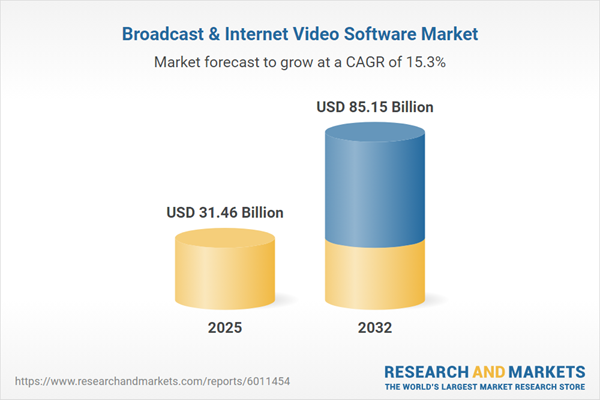Speak directly to the analyst to clarify any post sales queries you may have.
The broadcast and internet video software market is rapidly evolving, driven by continued advancements in digital delivery technology, changing viewership expectations, and growing integration across industries. This sea change offers senior decision-makers an opportunity to realign content delivery strategies and maximize enterprise value through informed adoption of next-generation video solutions.
Market Snapshot: Broadcast & Internet Video Software Market
The broadcast and internet video software market grew from USD 27.24 billion in 2024 to USD 31.46 billion in 2025. It is expected to continue growing at a CAGR of 15.31%, reaching USD 85.15 billion by 2032. This solid expansion reflects digital transformation across sectors, shifting viewer demands for interactive content, and the integration of AI, edge computing, and 5G connectivity into enterprise video workflows.
Scope & Segmentation of the Broadcast and Internet Video Software Market
This report delivers a comprehensive analysis of current and future trends, identifying actionable pathways for organizations operating across diverse regions and verticals. Market segmentation highlights the following:
- Component: Services including consulting & integration, managed services, professional services, support & maintenance. Software solutions addressing video analytics, content management, encoding, hosting platforms, and monetization.
- Streaming Type: Coverage of both live streaming and video-on-demand models, each with unique delivery and viewer engagement requirements.
- Deployment Mode: Options include cloud-based infrastructures and on-premise installations, responding to varying compliance, security, and scalability demands.
- End User: Detailed insights for corporate enterprises, educational institutions, government, healthcare, media & entertainment, retail & e-commerce, and sports & fitness domains.
- Application: Key uses span audience engagement, content creation, delivery, management, monetization, advertising, and security (including digital rights management).
- Geographical Coverage: Analysis spans the Americas (United States, Canada, Mexico, Brazil, Argentina, Chile, Colombia, Peru), Europe, Middle East & Africa (United Kingdom, Germany, France, Russia, Italy, Spain, Netherlands, Sweden, Poland, Switzerland, United Arab Emirates, Saudi Arabia, Qatar, Turkey, Israel, South Africa, Nigeria, Egypt, Kenya), and Asia-Pacific (China, India, Japan, Australia, South Korea, Indonesia, Thailand, Malaysia, Singapore, Taiwan).
- Key Companies: Assessment of major players such as Amazon Web Services, Microsoft, IBM, Adobe, Vimeo, Haivision, Brightcove, Kaltura, JW Player, and Wowza Media Systems.
Key Insights and Strategic Takeaways
- AI-driven analytics and real-time personalization solutions are reshaping how content is delivered and monetized, making data-driven engagement a competitive necessity.
- Deployment flexibility via hybrid, cloud-native, and on-premise infrastructures equips organizations to adapt quickly to regulatory and operational demands in distinct industries.
- The proliferation of live and on-demand streaming models encourages businesses to prioritize ultra-low latency, seamless user experiences, and scalable storage solutions.
- Strategic alliances, including collaborations between media, telecom, and technology providers, are accelerating the adoption of proprietary and open-source video platforms.
- Region-specific market dynamics, from mobile-first strategies in Asia-Pacific to advanced policy compliance in Europe, call for localized go-to-market tactics to ensure sustainable growth.
- Emerging verticals such as healthcare and retail are leveraging broadcast and internet video software to drive telemedicine, live shopping, and secure communications, signaling diversification of end-use applications.
Tariff Impact: Navigating Regulatory Headwinds in Video Software Supply Chains
The introduction of U.S. tariffs has added complexity and raised costs for hardware and software within the broadcast and internet video software ecosystem. Providers are responding through supplier diversification, renegotiating contracts, and leveraging open-source frameworks to reduce reliance on proprietary solutions. Emphasis on flexible licensing, managed services, and modular software design is helping mitigate cost pressures and support business continuity amid regulatory shifts.
Research Methodology & Data Sources
This report utilizes a mixed-method research approach. In-depth interviews with C-level executives, product leads, and solution architects are combined with rigorous secondary data collection from industry white papers, regulatory filings, patent databases, and financial disclosures. Findings were validated via triangulation and expert peer review to ensure accuracy and actionable insight across the broadcast and internet video software landscape.
Why This Report Matters
- Decision-makers gain guidance to align investment, operational, and innovation strategies with the most relevant market opportunities and risks.
- Granular regional and segmentation analysis supports tailored go-to-market planning and competitive positioning in high-growth sectors.
- Emerging technology, partnership, and regulatory themes are synthesized into clear, practical recommendations suitable for executive decision-making.
Conclusion
Overall, the broadcast and internet video software market offers a dynamic environment shaped by rapid technological progression, distinct regional drivers, and an expanding array of strategic applications. Organizations equipped with actionable data and strategic insight are best positioned to leverage evolving opportunities and maximize long-term value in this sector.
Additional Product Information:
- Purchase of this report includes 1 year online access with quarterly updates.
- This report can be updated on request. Please contact our Customer Experience team using the Ask a Question widget on our website.
Table of Contents
3. Executive Summary
4. Market Overview
7. Cumulative Impact of Artificial Intelligence 2025
Companies Mentioned
The companies profiled in this Broadcast & Internet Video Software market report include:- Amazon Web Services, Inc.
- Microsoft Corporation
- International Business Machines Corporation
- Adobe Inc.
- Vimeo, Inc.
- Haivision Systems Inc.
- Brightcove Inc.
- Kaltura, Inc.
- JW Player Corp.
- Wowza Media Systems, LLC
Table Information
| Report Attribute | Details |
|---|---|
| No. of Pages | 188 |
| Published | November 2025 |
| Forecast Period | 2025 - 2032 |
| Estimated Market Value ( USD | $ 31.46 Billion |
| Forecasted Market Value ( USD | $ 85.15 Billion |
| Compound Annual Growth Rate | 15.3% |
| Regions Covered | Global |
| No. of Companies Mentioned | 11 |









